► Moke Electric driven in the UK
► £36k beach car with 50-mile range
► Charming fun, but limiting spec
I’m not really sure where to start here. The basic premise is that you can buy an electric version of the classic Moke and that – for what it’s worth – it’s made in Britain again. The Moke Electric is, in fact, the only variant now available, meaning Moke is also the first ‘heritage brand’ to go 100 per cent EV. I’ve driven it and, on a gloriously sunny day in the Surrey countryside, it’s charming.
But it’s also £35,995, limited to 50mph, has a 54-mile WLTP driving range, and comes with a sort of awning arrangement instead of any conventional roof or doors. Like I said, classic Moke.
Except it’s not quite the same Mini-based affair that it was. The current iteration is a reworking by British designer Michael Young for Moke International, dating from 2016-2018. As well as having ‘over 160’ reengineered or replaced parts – and that’s pre-electric conversion, which also changes the Moke from front- to rear-wheel-drive – it’s around 10 per cent bigger. That still makes it pretty small, by modern standards, but at least you don’t feel like you’ll be crushed at every moment. Being bright orange obviously helps.
So far, so straightforward. What’s really baking my noodle is how a machine that’s – and I don’t mean to be rude – essentially four seats, a couple of metal box sections and a roll bar is apparently considered a luxury item by certain well-heeled strata of society, and what that means for the firm’s modern marketing plans. There are cultural and circumstantial reasons for this, but it’s still a bit of a brain-melter.
Join me as I try and get my head around what this all-electric beach car means in 2024.
At a glance
Pros: Retro appeal with an eco-conscience, fun in spirit, does what it needs to with plenty of charisma
Cons: Hard to escape the glorified road-legal golf cart naysayers, appeal is the very definition of niche
What’s new?
Time for a history lesson? The Moke originated as a prototype military vehicle in the late 1950s, created from Mini parts by Sir Alec Issigonis on behalf of BMC, and specced to be air-dropped – hence the compact size and stackable design. After a couple of iterations failed to live up to army expectations, BMC looked to monetise the results of its investment by unleashing the Moke on the public instead.
Its stripped-back aesthetic struck a chord (pun intended) with the rock and roll set in the 1960s as a kind of antidote to hedonism (or something), and the Moke acquired a cult following that still resonates today. You won’t have to look far in Google to find pictures of them being piloted in period by the likes of Bridget Bardot (lots of dogs) and the Beatles, just as you’ll soon find snaps of holidaying A-listers driving them now.

There are famous TV and film appearances, too, including four Bond movies for the original and the opening sequence of 2024’s Argylle (director Matthew Vaugn is apparently a Moke investor…) for the latest model. It’s their use as rental vehicles at class A destinations from St Barts to The Surf Club in Miami that seems to be fuelling – or electrifying – the current revival. Likely as a direct result of this, right now you’ll find one parked in Harrods and Selfridges, serving as a lifestyle prop for other luxury brands. Got a four- or five-figure handbag to flog? Hang it off the side of one of these.
From my nostalgia-lacking, A-list-ambivalent perspective, it’s all a bit… weird. And, depending on your perspective, possibly going to get weirder. In January 2024 Nick English joined the firm as executive chairman; English is the co-founder of highly successful British watch brand, Bremont. There is serious ambition here to position the Moke as a bona fide luxury product – the firm has spent ‘millions’ chasing down and reacquiring relevant trademarks globally – with a sprinkling of must-have sustainable kudos. Hence ditching the petrol engine (most recently sourced from Chery in China) completely.
Chief commercial officer Robin Kennedy is on hand to exclaim that one of their ultimate ambitions is for the Moke to be ‘powered by the sun’. Initially this means solar-powered chargers, but they are looking at incorporating solar cells into the vehicle itself. Something that low weight and a small battery pack might even make achievable. Maybe. This is all in keeping with the Moke’s idealised beach car ethos; its natural habitat is clearly sunnier climes.
The pricing is at once attainable – which is the aim – yet also faintly absurd. It seems highly unlikely that any ordinary person is going to buy one of these as their everyday electric car. But it’s not impossible to imagine your more laidback kind of car enthusiast tucking one into the garage for funday drives in the same way that other types choose an Ariel Atom or a Caterham. After all, there are plenty of original Mokes occupying this road space in the UK.
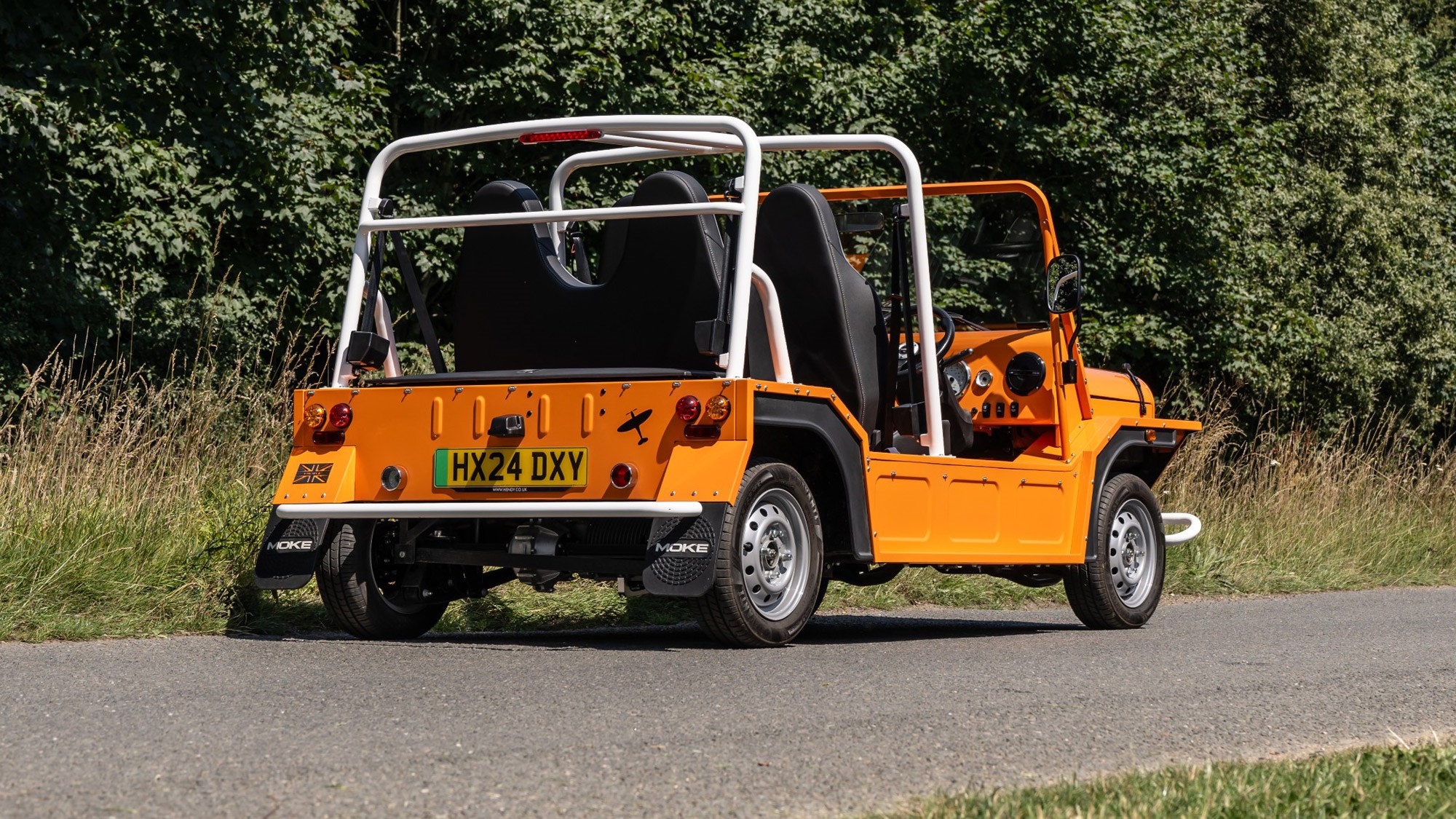
Sticking to the modern model, £36k feels like a lot for what you get in exchange. But considered in the context of Moke’s true target audience – high net worth individuals who are essentially ‘recession proof’ and able to casually sign-off on one or several of these after a particularly good vacation lunch, in the way the rest of us might get carried away with a case of the local wine – then it’s about as affordable as a quality fountain pen and much less expensive than many hi-fi components, let alone ticking wrist-ware and other jewellery.
For instance, a pair of specially customised Mokes were auctioned off for the Blue Marine Foundation charity in 2022 and raised 250,000 Euros. Each.
Then there’s that rental market to consider. Moke’s current strategy is to work with a single hotel or group in each region. Hence the starting location for today’s drive at Beaverbrook – the cars in the pictures aren’t from any press fleet, they’re this summer’s edition of an automotive add-on exclusively available to guests at the country house retreat.
What are the specs?
Those 50mph / 54-mile WLTP headline figures don’t really tell the whole story. The top speed is capped to maximise the range, which Moke says is more like 45-80 miles, depending on how and where you drive it; its own are real-world ‘cities and coastlines’ figures, apparently. I easily managed 25 miles on half a charge whilst being thoroughly unsympathetic and Moke isn’t expecting anyone to take the car far enough in one hit to risk getting stranded, but four-up you’re going to need to be careful.
Charging is via the novelty of a three-pin plug, so you aren’t limited to or aided by traditional charging destinations. Because the battery is a tiny 10.5kWh unit, stashed under the bonnet, you still get an 80 per cent charge in two hours – probably quick enough if you’re driving out to a lazy repast. A full charge takes four hours.
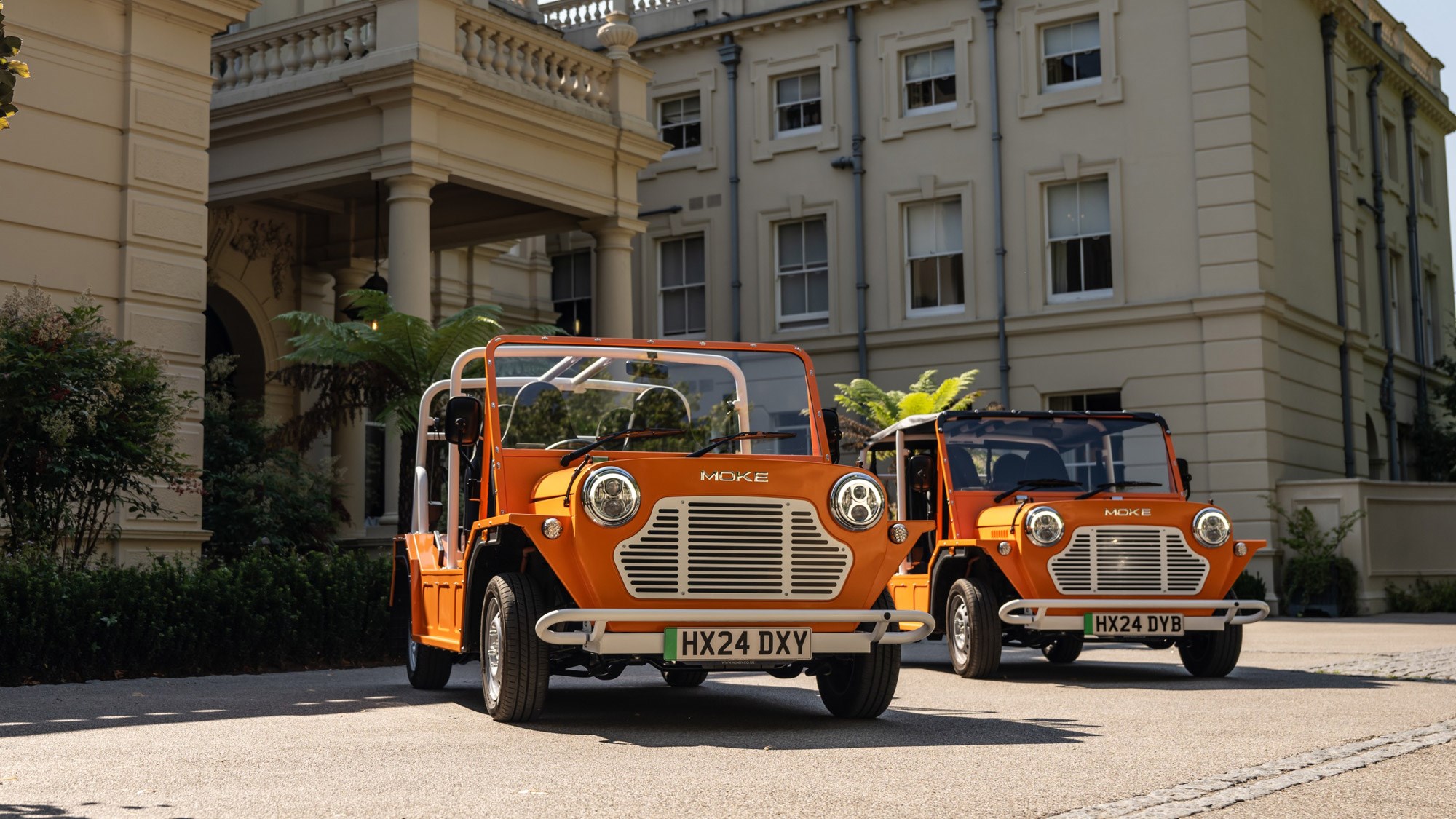
Maximum power is 33kW – equivalent to just 44bhp. Before you get too aghast, realise that’s the same as the Dacia Spring, a genuine mainstream full-production electric car. And although you could buy nearly two and a half of those for the cost of a Moke Electric, the Moke is at least even lighter.
Weighing 816kg means it’ll do 0-30mph in 4.5sec, and you’re looking at potentially six miles per kilowatt hour of battery capacity; Moke says its investigating ways to increase the driving range, but that hardly seems a high priority. Three driving modes are available: Cruise (normal), Coast (eco) and Beach – the latter managing the towering 96lb ft of torque to avoid digging trenches in sand.
Moke has spent a small fortune getting the electric version certified for low volume sale in Europe and the USA. Achieving EU M1 small series approval required ‘over 200 regulatory and safety tests’, including some modest crash testing. But there are no airbags or other aids, and I wouldn’t want to be the one to physically endure quality assuring the results.
How does it drive?
The Moke presentation ahead of the drive included a slide on rivals. And fair play, the main alternative listed was a fancy golf cart. The Moke Electric has many advantages over one of those, not least of which being road legality and a turn of speed decent enough to not be a hazard to other traffic. This also sets it apart from the Citroen Ami.
In fact, for a tea tray with wheels and windscreen it’s more than quick enough. That 4.5sec 0-30mph figure doesn’t sound like much but the Moke is not only pretty nippy, like all small electric cars, it’s very dependably so. I had no hesitation hitting gaps exiting junctions that I’d have thought twice about in the Honda CR-V plug-in hybrid I’d driven down in. Zap and go.
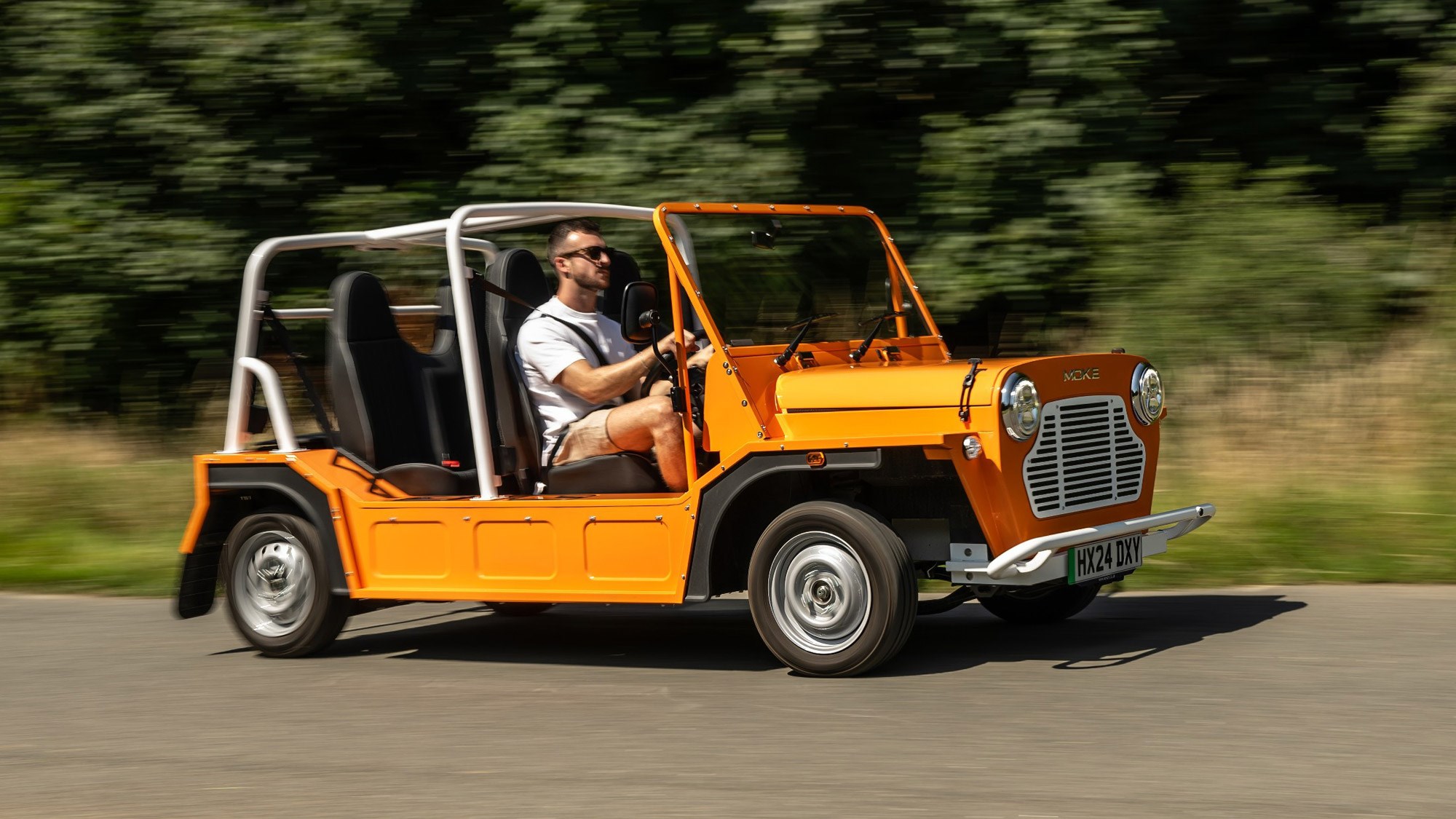
There’s not much cornering inertia, either. The steering is unassisted, so heavy at parking speeds and doesn’t fully self-centre, but easy enough to manage once you’re moving. It doesn’t give you a huge amount of feedback, but you can get the Moke to turn-in with fairly hilarious sharpness, and there’s likely some fun to be had scaring your passengers on roundabouts. In the dry, grip is never an issue, though wet weather may add some further entertainment.
The ride is stiff, but not excessively so. Pay attention to speed bumps, but it’s only really sudden dips in the road surface that threaten to fully unsettle the Moke at the speeds its capable of going. Being so narrow takes the threat of oncoming locals out of back-lane driving, and the brakes are satisfyingly sharp and easily to modulate – something that’s again helped by the relatively low weight.
Everything is made all the more visceral by the absence of surrounding panels, which takes the whole exposure to your environment thing to a higher level. As such, 50mph is fast enough to bring on a mild chill in the British summer shade, not to mention whip your hair about in a fairly distracting fashion. All part of the fun.
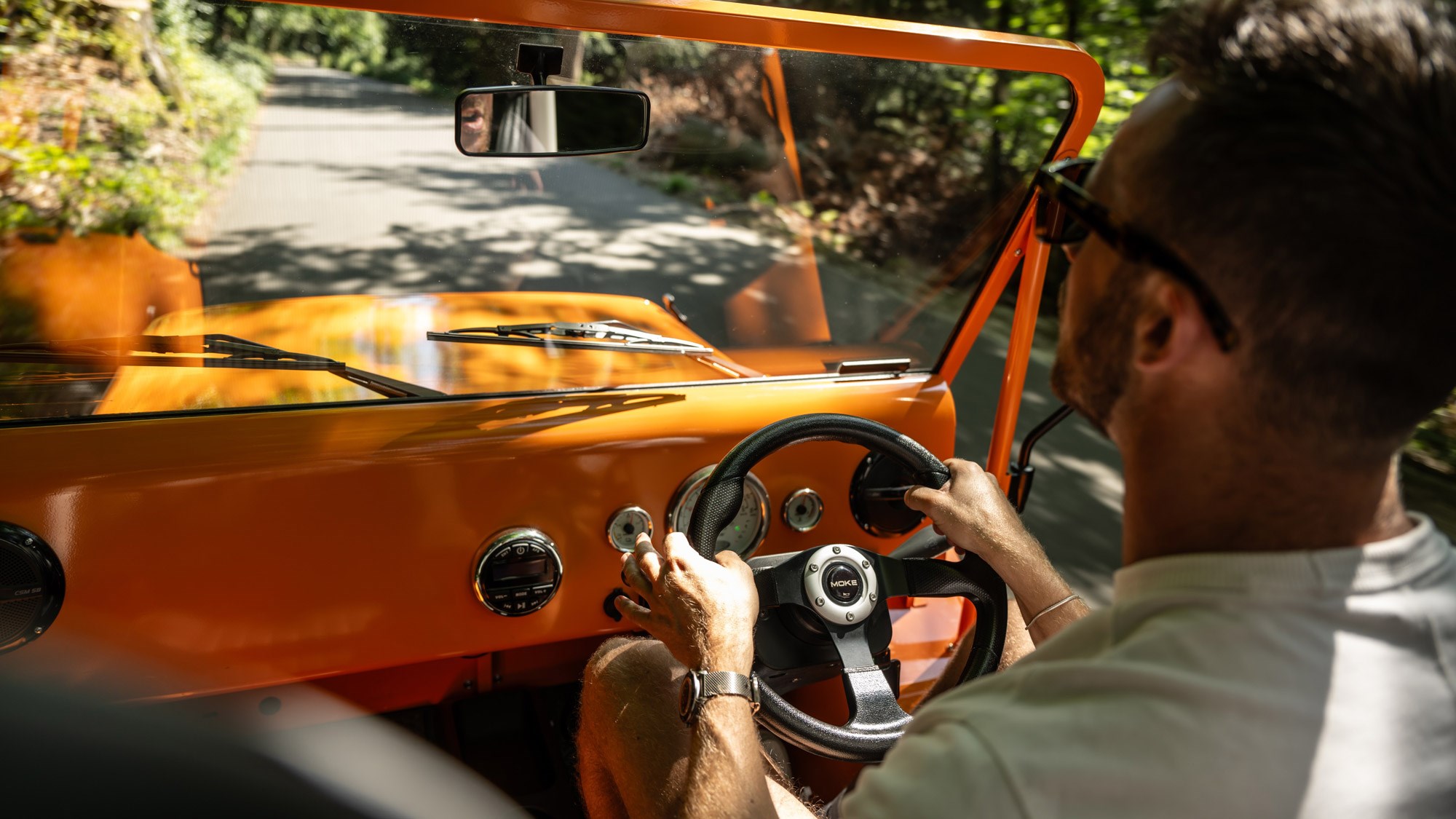
There are some less attractive novelties. The low-speed pedestrian warning sound made me feel like I was actually in The Prisoner with its 1960s sci-fi vibe, but once this goes away you are presented with plenty of creaks and rattles that would probably be masked by a chuntering petrol engine. While I stopped and did up the rear seatbelts to prevent them vibrating, there is a marine-grade Bluetooth-enable radio that is loud enough to drown most of this out, too.
Hill starts require a touch of commitment, as there’s a moment when the Moke will roll backwards before the single-speed transmission takes up the slack. And though it isn’t fazed by countryside traffic and is torquey enough to maintain higher speeds uphill, really fast roads aren’t to be recommended, and with every seat filled you may be in for more trouble.
What about the interior?
The interior is very simple, with a few dials, the stereo and the speakers planted in a nicely finished body-coloured dash panel, four seats, and a steering wheel. You select Drive, Neutral and Reverse via push buttons between the front seats and there’s a good old-fashioned manual handbrake behind these, which reputedly catches some people out.
The driving position is something of a splayed knee affair, which would probably be a pain if I was wearing a skirt but otherwise shouldn’t cause too many problems given the likely short length of each drive. It’s not quite roomy enough for me to comfortably sit behind myself, but two times 5’11” is easily accommodated on the passenger side. I was pleasantly surprised to discover Isofix mountings on the rear seats, so you can bring the kids. Dammit.
As the marine-grade speakers suggest, the whole thing can be hosed out, should you get carried away and half-bury your electric Moke in a sand dune.
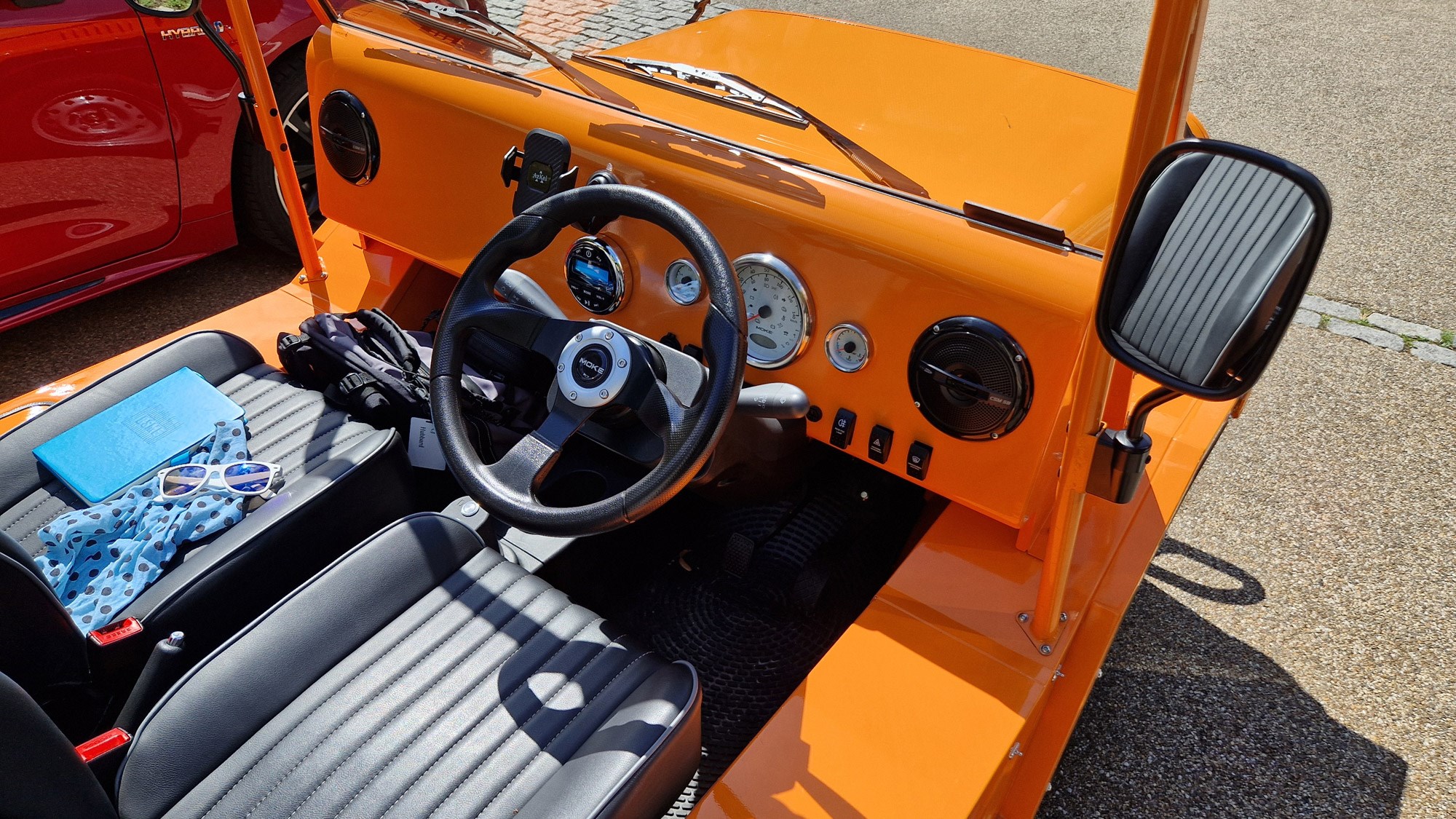
Rumour has it, Moke is planning to bring production in-house as soon as it can – having bounced around the world to locations including Portugal, Australia, China and France, it’s currently back with a contractor in the UK. A decision actually encouraged by Brexit, I’m told.
Reason I mention this is that if production does come back under Moke’s direct control, I’d encourage it to find some better welders. The finish on the windscreen support struts in particular didn’t strike me as especially premium, though I have to say the side mirrors attached to this component vibrate far less on the Moke Electric than they did on the Morgan Plus Six I’ve driven recently…
There’s a lockable box behind the rear seats for storage – the lockable part being pertinent when the ‘doors’, if you even have them, are only held in place by poppers – plus four lidded sections in the two side sills. Three of these grant access to components such as the 12v battery and the charging port; the fourth is empty, and commodious enough to absorb the charging cable alongside plenty of other gubbins. Sun cream, for example.
Before you buy (trims and rivals)
There are no engine variants or trim levels to choose from in the UK, and only two factory options and five paint colours at the moment – though Moke would be mad not to be looking at a bespoke department if what it says about the clientele is true.
The options are alloy wheels at £995 and a full canopy to replace the standard, open-sided bimini roof. An upgrade that costs £1500.
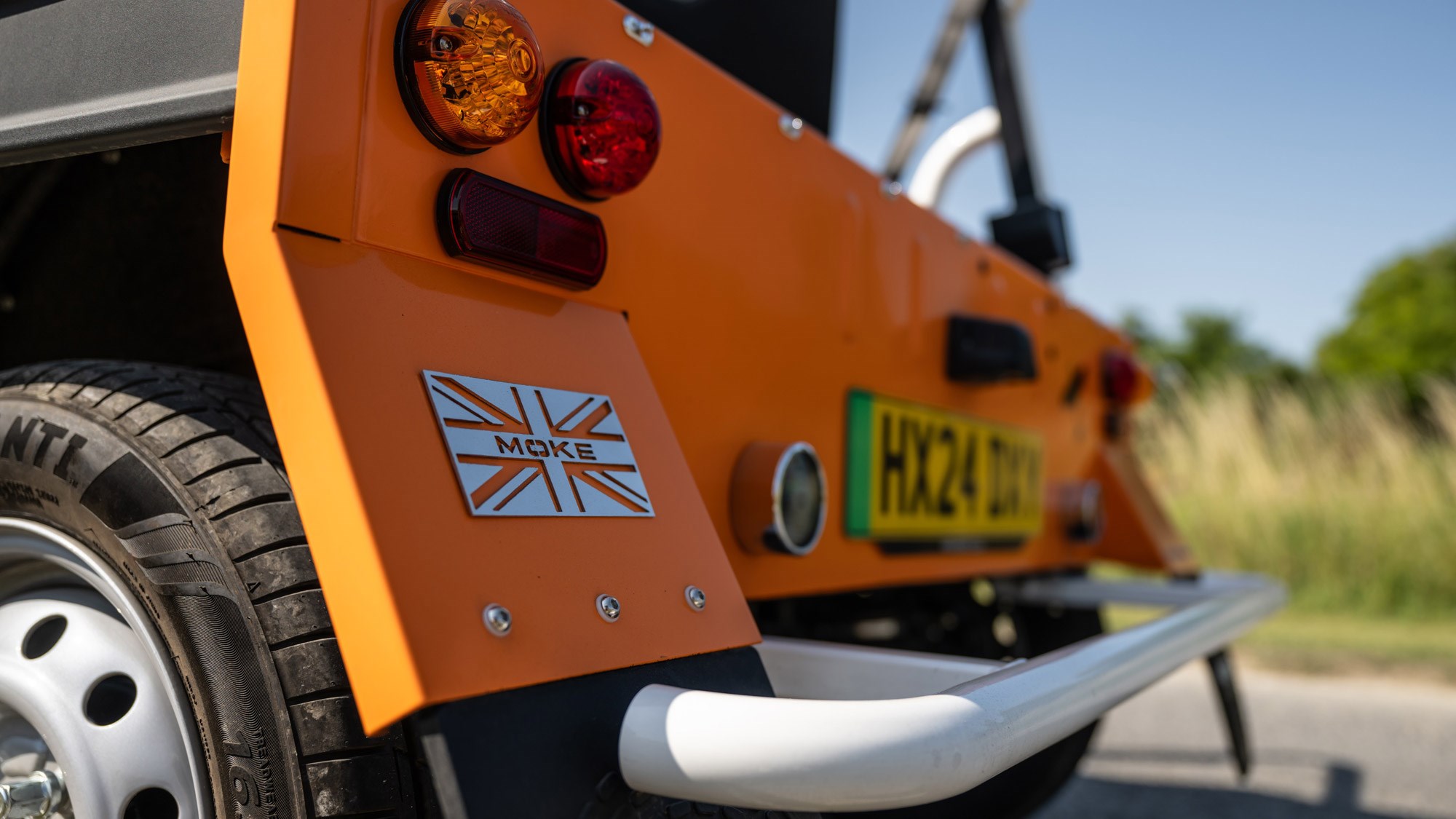
Aside from the golf cart, Moke considers smaller off-roaders – from Jeep in particular – to be the lifestyle competition. The Citroen Ami Buggy wasn’t mentioned, perhaps because it’s limited to 28mph. Frankly, I suspect that if you want a Moke, you want a Moke, and there’s not much else out there to change your mind.
Although it does seem there’s a plan afoot to build an all-electric Meyers Manx dune buggy, the starting price is $74,000 (roughly £58k right now) and there’s no firm date for production.
Verdict
So what are we to make of the Moke Electric? It’s a kind of madness, really, but a thoroughly harmless one that’s rather good fun to punt about in when the weather’s cooperating. That alone would seem to limit the appeal among buyers in the British Isle, but we’re an eclectic bunch and I can’t see you generating anything but smiles if you should choose to pop one of these under the car port.
Find out more about how CAR tests cars.